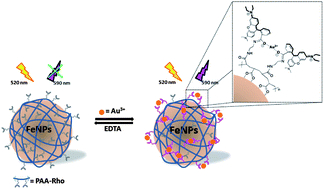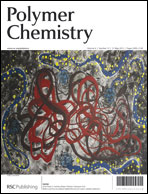Rhodamine derivatives were grafted on poly(acrylic acid) or PAA to obtain hydrophobically modified PAA (PAA-Rho1–4) bearing rhodamine moieties. Polymeric sensors were simply prepared by amidation reactions between PAA and rhodamine of various mole ratios to obtain PAA-Rho1, PAA-Rho2, PAA-Rho3 and PAA-Rho4 in 83%, 82%, 75% and 81% yields, respectively. Chemical compositions of PAA-Rho1–4 were studied by IR and 1H NMR spectroscopy. Chemical structures and purity of polymeric sensors were characterized by TGA, NMR, TEM and IR. It was found that polymeric sensors exhibited high selectivity and sensitivity in colorimetric and fluorescence responses toward Au3+ over other metal ions. The polymeric sensors were non-fluorescent in the spirolactam form and could be selectively converted into the fluorescent ring-opened amide form in the presence of Au3+ ions that lead to fluorescence enhancements and colorimetric changes. DFT calculation results suggested that the polymeric sensor PAA-Rho2 formed stable complexes with Au3+ through a large number of cation–dipole and ion–ion interactions. Moreover, the higher density carboxylic groups at the backbone of PAA-Rho interacted strongly with monodisperse superparamagnetic Fe3O4 NPs (FeNPs) which provided organic–inorganic hybrid fluorescence sensors (PAA-Rho2-FeNPs). The lower detection limit of the hybrid sensor toward Au3+ (0.85 μM) was less than that obtained from PAA-Rho2 (11.40 μM), and the response time was less than 40 seconds. Reusability was evaluated by repeating dipping and rinsing cycles in aqueous Au3+ and EDTA solutions. This approach may provide an easily measurable and inherently sensitive method for Au3+ ion detection in environmental and biological applications.

You have access to this article
 Please wait while we load your content...
Something went wrong. Try again?
Please wait while we load your content...
Something went wrong. Try again?


 Please wait while we load your content...
Please wait while we load your content...